FUTURE IMAGINARIES: INDIGENOUS ART, FASHION & TECHNOLOGY
Future Imaginaries, the collective exhibition at The Autry Museum of the American West, explores the rise of Futurism in contemporary Indigenous art as a means of enduring colonial trauma, creating alternative futures and advocating for Indigenous technologies in a more inclusive present and sustainable future.
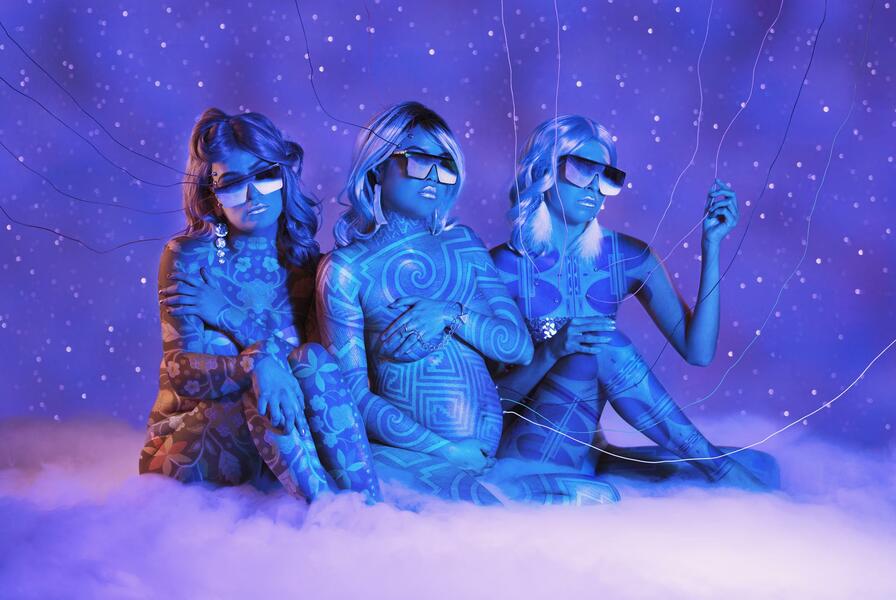
As the artist Rose Simpson (Santa Clara Pueblo Descent) explains, from her perspective, the idea of apocalypse is “an opportunity for innovation and for reflection and renewal. In a sense…Indigenous people have been at a privilege when it comes to any kind of hardship because we’ve already survived.”
With the rise of the Red Power and the American Indian Movement in the 1970s, Native artists began looking to science fiction and imagined futures as a means of reclaiming agency within an increasingly technological society. By re-imagining aspects of pre-contact culture such as sovereignty, Indigenous technologies and sustainable lifeways in dialogue with both contemporary life and future imaginaries.
Indigenous artists today are redefining what constitutes Native American art, helping their communities to heal from intergenerational trauma and creating pathways to a better life for Indigenous peoples and our shared planet.
-
Will Wilson (Diné), K’ómoks Imperial Stormtrooper (Andy Everson), Citizen of the K’ómoks First Nation, from the Critical Indigenous Photographic Exchange, dzidz elalic series, 2017, printed 2019. Archival pigment print, 56 ¼ x 44 ¼ in. Courtesy of the artist.
-
Three Sisters, 2022 Courtesy of Cara Romero (Chemehuevi)
-
Will Wilson (Diné), K’ómoks Imperial Stormtrooper (Andy Everson), Citizen of the K’ómoks First Nation, from the Critical Indigenous Photographic Exchange, dzidz elalic series, 2017, printed 2019. Archival pigment print, 56 ¼ x 44 ¼ in. Courtesy of the artist.
-
Stirs up the Dust, 2011, Wendy Red Star. Gift of Loren G. Lipson, M.D., Autry Museum, Los Angeles; Courtesy of Wendy Red Star. Autry museum of the American West, 2018.
-
Jai Nopek, Recon Watchman, 2022. Courtesy of Virgil Ortiz (Cochiti Pueblo).
Featuring works of art ranging in size from jewelry and elaborately dressed mannequins to monumental sculptures and room-sized installations, Future Imaginaries will intersperse works throughout the museum, creating unexpected encounters and dialogues between contemporary Indigenous creations and historic works from the Autry collections.
The exhibition comprises approximately 58 works, including 50 loans, most directly from the artists. At least nine new works were created for the exhibition, including the site-specific installations ReVolt 1680/2180: Sirens and Sikas by Virgil Ortiz and Stirs Up the Dust by Wendy Red Star.
Future Imaginaries: Indigenous Art, Fashion, Technology is among more than 70 exhibitions and programs presented as part of PST ART. Returning in September 2024 with its latest edition, PST ART: Art & Science Collide, this landmark regional event explores the intersections of art and science, both past and present.
Related Topics
May interest you
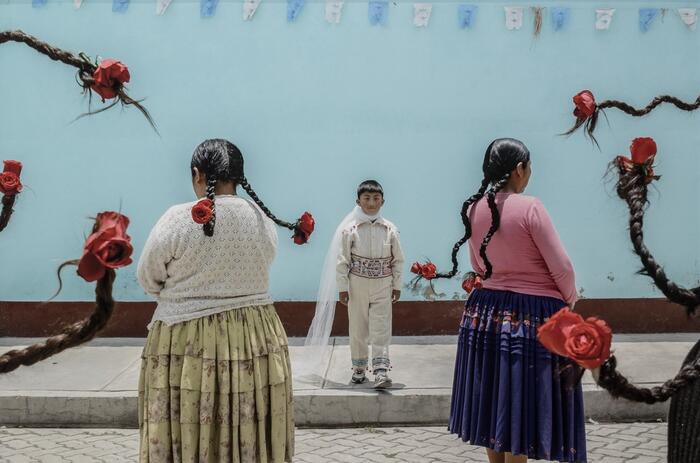
Why highlight stories that often remain on the periphery of artistic discourse? Adriano Pedrosa justifies his curatorial decision with works by 331 artists -mostly from the global south- that open the way to powerful narratives. Finally, we see the axis being twisted. It is difficult to escape the white gaze, more so to move authentically through a Eurocentric space. Given this, the communicative reach of figuration serves to challenge the symbolic order of domination and destabilize the colonial project. The stories that are made explicit and the narratives of magic and everyday life help to recognize without revictimizing.
STORIES FROM THE SOUTH – THE VENICE BIENNALE TURNS AROUND ITS AXIS
Why highlight stories that often remain on the periphery of artistic discourse? Adriano Pedrosa justifies his curatorial decision with works by 331 artists -mostly from the global south- that open the way to powerful narratives. Finally, we see the axis being twisted. It is difficult to escape the white gaze, more so to move authentically through a Eurocentric space. Given this, the communicative reach of figuration serves to challenge the symbolic order of domination and destabilize the colonial project. The stories that are made explicit and the narratives of magic and everyday life help to recognize without revictimizing.

Why highlight stories that often remain on the periphery of artistic discourse? Adriano Pedrosa justifies his curatorial decision with works by 331 artists -mostly from the global south- that open the way to powerful narratives. Finally, we see the axis being twisted. It is difficult to escape the white gaze, more so to move authentically through a Eurocentric space. Given this, the communicative reach of figuration serves to challenge the symbolic order of domination and destabilize the colonial project. The stories that are made explicit and the narratives of magic and everyday life help to recognize without revictimizing.
STORIES FROM THE SOUTH – THE VENICE BIENNALE TURNS AROUND ITS AXIS
Why highlight stories that often remain on the periphery of artistic discourse? Adriano Pedrosa justifies his curatorial decision with works by 331 artists -mostly from the global south- that open the way to powerful narratives. Finally, we see the axis being twisted. It is difficult to escape the white gaze, more so to move authentically through a Eurocentric space. Given this, the communicative reach of figuration serves to challenge the symbolic order of domination and destabilize the colonial project. The stories that are made explicit and the narratives of magic and everyday life help to recognize without revictimizing.
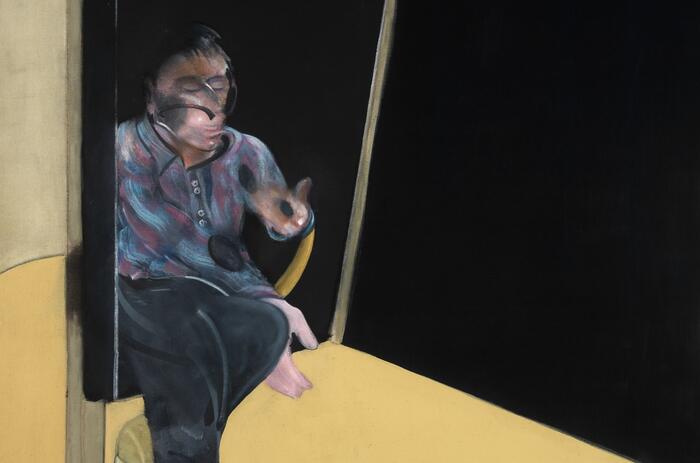
A man is waiting. In elegant clothes, the figure is placed in the center of what looks like a hotel bar. He plays the lead role on a sort of stage, an interior that is something of a cage, something of a scenic locus, as if a possible flirtation or a desired encounter would provide some catalysis of emergence, a quick enjoyment, an intense release, however short and finite, perhaps dismantling a routine of limits. Man in Blue (1954) works as a synthesis of the not so extensive but very significant gathering of the celebrated Francis Bacon (1909-1992) in A Beleza da Carne (The Beauty of Meat), at Masp (São Paulo Museum of Art). The exhibition is curated by Adriano Pedrosa, artistic director of the institution and curator of the current edition of the Venice Biennale, the 60th, on show until November in the Italian city, and co-curated by Laura Cosendey.
BODY INSIDE OUT - FRANCIS BACON, THE BEAUTY OF MEAT
A man is waiting. In elegant clothes, the figure is placed in the center of what looks like a hotel bar. He plays the lead role on a sort of stage, an interior that is something of a cage, something of a scenic locus, as if a possible flirtation or a desired encounter would provide some catalysis of emergence, a quick enjoyment, an intense release, however short and finite, perhaps dismantling a routine of limits. Man in Blue (1954) works as a synthesis of the not so extensive but very significant gathering of the celebrated Francis Bacon (1909-1992) in A Beleza da Carne (The Beauty of Meat), at Masp (São Paulo Museum of Art). The exhibition is curated by Adriano Pedrosa, artistic director of the institution and curator of the current edition of the Venice Biennale, the 60th, on show until November in the Italian city, and co-curated by Laura Cosendey.
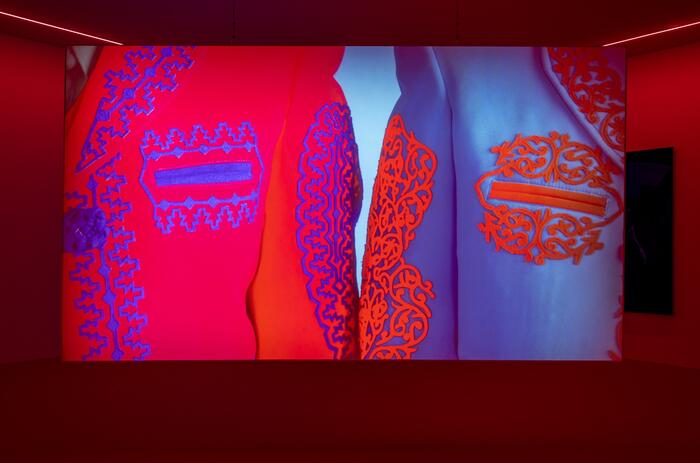
The voices of Latin American artists emerge strongly in this 2024 edition of the Venice Biennale. Claudia Alarcón, Julia Isídrez and Juana Marta Rodas, Ana Segovia, Frieda Toranzo Jaeger and Claudia Andújar lead viewers on a profound journey through their cultural heritage and unique artistic practices.
FIVE LATIN AMERICAN ARTISTS EXHIBITING FOR THE FIRST TIME AT THE VENICE BIENNALE
The voices of Latin American artists emerge strongly in this 2024 edition of the Venice Biennale. Claudia Alarcón, Julia Isídrez and Juana Marta Rodas, Ana Segovia, Frieda Toranzo Jaeger and Claudia Andújar lead viewers on a profound journey through their cultural heritage and unique artistic practices.
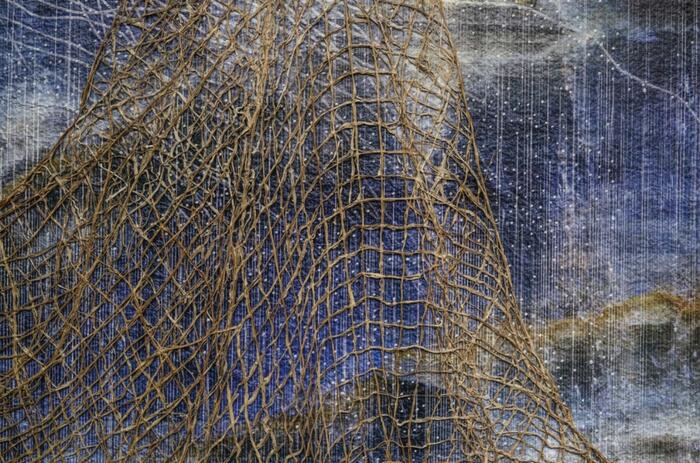
Lehmann Maupin presented Astral Sea, an exhibition of new work by New York-based artist Teresita Fernández. Featuring a series of glazed ceramic pieces and new sculptural paper panels, Astral Sea extends the artist’s interests in the confluence points of the cosmos, land, and water, as seen through the lens of an embodied sculptural landscape.
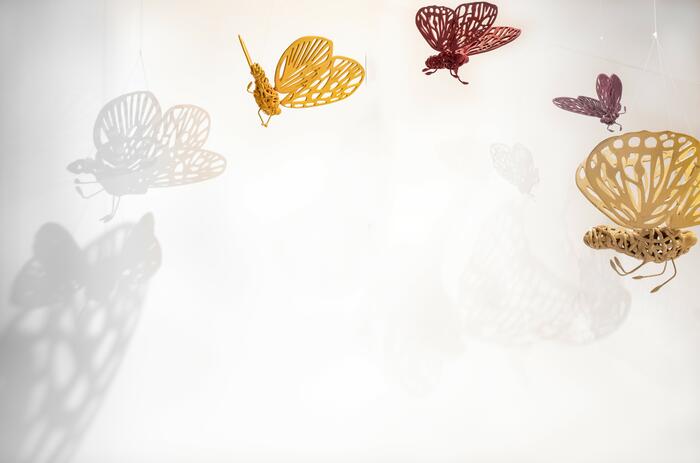
Banco Macro presented El Oro de los sueños (The Gold of Dreams), the exhibition by Andrés Paredes which is part of a new artistic program within its agenda at the Corporate Tower. The program is called Macro Federal, an initiative to present artists from all the provinces of Argentina, starting with Misiones. It is curated by Patricia Rizzo.
THE GOLD OF DREAMS: ANDRÉS PAREDES AT THE MACRO TOWER
Banco Macro presented El Oro de los sueños (The Gold of Dreams), the exhibition by Andrés Paredes which is part of a new artistic program within its agenda at the Corporate Tower. The program is called Macro Federal, an initiative to present artists from all the provinces of Argentina, starting with Misiones. It is curated by Patricia Rizzo.
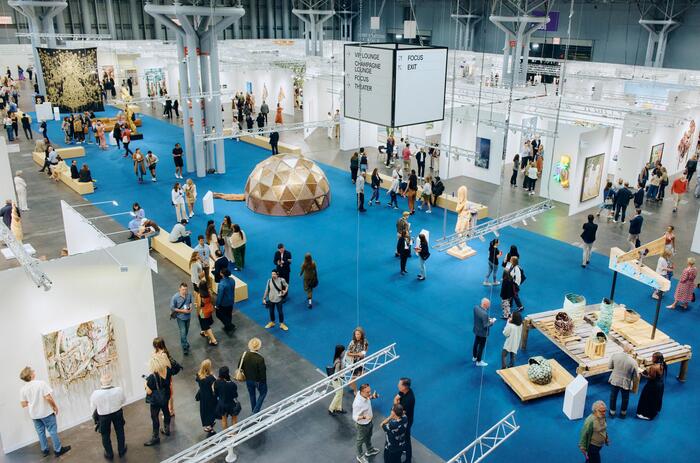
The Armory Show is taking place from September 6th to 8th. The fair’s 30th edition features over 235 galleries from 35 countries, showcasing artist projects in the Platform section, as well as highlights from sections Galleries, Focus, Solo and Presents, alongside presentation details for the Gramercy International Prize. Now part of the Frieze network, the Armory Show presents a revitalized program that offers a comprehensive view of the contemporary art world.
THE ARMORY SHOW’S 30th ANNIVERSARY EDITION
The Armory Show is taking place from September 6th to 8th. The fair’s 30th edition features over 235 galleries from 35 countries, showcasing artist projects in the Platform section, as well as highlights from sections Galleries, Focus, Solo and Presents, alongside presentation details for the Gramercy International Prize. Now part of the Frieze network, the Armory Show presents a revitalized program that offers a comprehensive view of the contemporary art world.

Why highlight stories that often remain on the periphery of artistic discourse? Adriano Pedrosa justifies his curatorial decision with works by 331 artists -mostly from the global south- that open the way to powerful narratives. Finally, we see the axis being twisted. It is difficult to escape the white gaze, more so to move authentically through a Eurocentric space. Given this, the communicative reach of figuration serves to challenge the symbolic order of domination and destabilize the colonial project. The stories that are made explicit and the narratives of magic and everyday life help to recognize without revictimizing.
STORIES FROM THE SOUTH – THE VENICE BIENNALE TURNS AROUND ITS AXIS
Why highlight stories that often remain on the periphery of artistic discourse? Adriano Pedrosa justifies his curatorial decision with works by 331 artists -mostly from the global south- that open the way to powerful narratives. Finally, we see the axis being twisted. It is difficult to escape the white gaze, more so to move authentically through a Eurocentric space. Given this, the communicative reach of figuration serves to challenge the symbolic order of domination and destabilize the colonial project. The stories that are made explicit and the narratives of magic and everyday life help to recognize without revictimizing.

A man is waiting. In elegant clothes, the figure is placed in the center of what looks like a hotel bar. He plays the lead role on a sort of stage, an interior that is something of a cage, something of a scenic locus, as if a possible flirtation or a desired encounter would provide some catalysis of emergence, a quick enjoyment, an intense release, however short and finite, perhaps dismantling a routine of limits. Man in Blue (1954) works as a synthesis of the not so extensive but very significant gathering of the celebrated Francis Bacon (1909-1992) in A Beleza da Carne (The Beauty of Meat), at Masp (São Paulo Museum of Art). The exhibition is curated by Adriano Pedrosa, artistic director of the institution and curator of the current edition of the Venice Biennale, the 60th, on show until November in the Italian city, and co-curated by Laura Cosendey.
BODY INSIDE OUT - FRANCIS BACON, THE BEAUTY OF MEAT
A man is waiting. In elegant clothes, the figure is placed in the center of what looks like a hotel bar. He plays the lead role on a sort of stage, an interior that is something of a cage, something of a scenic locus, as if a possible flirtation or a desired encounter would provide some catalysis of emergence, a quick enjoyment, an intense release, however short and finite, perhaps dismantling a routine of limits. Man in Blue (1954) works as a synthesis of the not so extensive but very significant gathering of the celebrated Francis Bacon (1909-1992) in A Beleza da Carne (The Beauty of Meat), at Masp (São Paulo Museum of Art). The exhibition is curated by Adriano Pedrosa, artistic director of the institution and curator of the current edition of the Venice Biennale, the 60th, on show until November in the Italian city, and co-curated by Laura Cosendey.

The voices of Latin American artists emerge strongly in this 2024 edition of the Venice Biennale. Claudia Alarcón, Julia Isídrez and Juana Marta Rodas, Ana Segovia, Frieda Toranzo Jaeger and Claudia Andújar lead viewers on a profound journey through their cultural heritage and unique artistic practices.
FIVE LATIN AMERICAN ARTISTS EXHIBITING FOR THE FIRST TIME AT THE VENICE BIENNALE
The voices of Latin American artists emerge strongly in this 2024 edition of the Venice Biennale. Claudia Alarcón, Julia Isídrez and Juana Marta Rodas, Ana Segovia, Frieda Toranzo Jaeger and Claudia Andújar lead viewers on a profound journey through their cultural heritage and unique artistic practices.

Lehmann Maupin presented Astral Sea, an exhibition of new work by New York-based artist Teresita Fernández. Featuring a series of glazed ceramic pieces and new sculptural paper panels, Astral Sea extends the artist’s interests in the confluence points of the cosmos, land, and water, as seen through the lens of an embodied sculptural landscape.

Banco Macro presented El Oro de los sueños (The Gold of Dreams), the exhibition by Andrés Paredes which is part of a new artistic program within its agenda at the Corporate Tower. The program is called Macro Federal, an initiative to present artists from all the provinces of Argentina, starting with Misiones. It is curated by Patricia Rizzo.
THE GOLD OF DREAMS: ANDRÉS PAREDES AT THE MACRO TOWER
Banco Macro presented El Oro de los sueños (The Gold of Dreams), the exhibition by Andrés Paredes which is part of a new artistic program within its agenda at the Corporate Tower. The program is called Macro Federal, an initiative to present artists from all the provinces of Argentina, starting with Misiones. It is curated by Patricia Rizzo.

The Armory Show is taking place from September 6th to 8th. The fair’s 30th edition features over 235 galleries from 35 countries, showcasing artist projects in the Platform section, as well as highlights from sections Galleries, Focus, Solo and Presents, alongside presentation details for the Gramercy International Prize. Now part of the Frieze network, the Armory Show presents a revitalized program that offers a comprehensive view of the contemporary art world.
THE ARMORY SHOW’S 30th ANNIVERSARY EDITION
The Armory Show is taking place from September 6th to 8th. The fair’s 30th edition features over 235 galleries from 35 countries, showcasing artist projects in the Platform section, as well as highlights from sections Galleries, Focus, Solo and Presents, alongside presentation details for the Gramercy International Prize. Now part of the Frieze network, the Armory Show presents a revitalized program that offers a comprehensive view of the contemporary art world.

Why highlight stories that often remain on the periphery of artistic discourse? Adriano Pedrosa justifies his curatorial decision with works by 331 artists -mostly from the global south- that open the way to powerful narratives. Finally, we see the axis being twisted. It is difficult to escape the white gaze, more so to move authentically through a Eurocentric space. Given this, the communicative reach of figuration serves to challenge the symbolic order of domination and destabilize the colonial project. The stories that are made explicit and the narratives of magic and everyday life help to recognize without revictimizing.
STORIES FROM THE SOUTH – THE VENICE BIENNALE TURNS AROUND ITS AXIS
Why highlight stories that often remain on the periphery of artistic discourse? Adriano Pedrosa justifies his curatorial decision with works by 331 artists -mostly from the global south- that open the way to powerful narratives. Finally, we see the axis being twisted. It is difficult to escape the white gaze, more so to move authentically through a Eurocentric space. Given this, the communicative reach of figuration serves to challenge the symbolic order of domination and destabilize the colonial project. The stories that are made explicit and the narratives of magic and everyday life help to recognize without revictimizing.

A man is waiting. In elegant clothes, the figure is placed in the center of what looks like a hotel bar. He plays the lead role on a sort of stage, an interior that is something of a cage, something of a scenic locus, as if a possible flirtation or a desired encounter would provide some catalysis of emergence, a quick enjoyment, an intense release, however short and finite, perhaps dismantling a routine of limits. Man in Blue (1954) works as a synthesis of the not so extensive but very significant gathering of the celebrated Francis Bacon (1909-1992) in A Beleza da Carne (The Beauty of Meat), at Masp (São Paulo Museum of Art). The exhibition is curated by Adriano Pedrosa, artistic director of the institution and curator of the current edition of the Venice Biennale, the 60th, on show until November in the Italian city, and co-curated by Laura Cosendey.
BODY INSIDE OUT - FRANCIS BACON, THE BEAUTY OF MEAT
A man is waiting. In elegant clothes, the figure is placed in the center of what looks like a hotel bar. He plays the lead role on a sort of stage, an interior that is something of a cage, something of a scenic locus, as if a possible flirtation or a desired encounter would provide some catalysis of emergence, a quick enjoyment, an intense release, however short and finite, perhaps dismantling a routine of limits. Man in Blue (1954) works as a synthesis of the not so extensive but very significant gathering of the celebrated Francis Bacon (1909-1992) in A Beleza da Carne (The Beauty of Meat), at Masp (São Paulo Museum of Art). The exhibition is curated by Adriano Pedrosa, artistic director of the institution and curator of the current edition of the Venice Biennale, the 60th, on show until November in the Italian city, and co-curated by Laura Cosendey.

The voices of Latin American artists emerge strongly in this 2024 edition of the Venice Biennale. Claudia Alarcón, Julia Isídrez and Juana Marta Rodas, Ana Segovia, Frieda Toranzo Jaeger and Claudia Andújar lead viewers on a profound journey through their cultural heritage and unique artistic practices.
FIVE LATIN AMERICAN ARTISTS EXHIBITING FOR THE FIRST TIME AT THE VENICE BIENNALE
The voices of Latin American artists emerge strongly in this 2024 edition of the Venice Biennale. Claudia Alarcón, Julia Isídrez and Juana Marta Rodas, Ana Segovia, Frieda Toranzo Jaeger and Claudia Andújar lead viewers on a profound journey through their cultural heritage and unique artistic practices.

Lehmann Maupin presented Astral Sea, an exhibition of new work by New York-based artist Teresita Fernández. Featuring a series of glazed ceramic pieces and new sculptural paper panels, Astral Sea extends the artist’s interests in the confluence points of the cosmos, land, and water, as seen through the lens of an embodied sculptural landscape.

Banco Macro presented El Oro de los sueños (The Gold of Dreams), the exhibition by Andrés Paredes which is part of a new artistic program within its agenda at the Corporate Tower. The program is called Macro Federal, an initiative to present artists from all the provinces of Argentina, starting with Misiones. It is curated by Patricia Rizzo.
THE GOLD OF DREAMS: ANDRÉS PAREDES AT THE MACRO TOWER
Banco Macro presented El Oro de los sueños (The Gold of Dreams), the exhibition by Andrés Paredes which is part of a new artistic program within its agenda at the Corporate Tower. The program is called Macro Federal, an initiative to present artists from all the provinces of Argentina, starting with Misiones. It is curated by Patricia Rizzo.

The Armory Show is taking place from September 6th to 8th. The fair’s 30th edition features over 235 galleries from 35 countries, showcasing artist projects in the Platform section, as well as highlights from sections Galleries, Focus, Solo and Presents, alongside presentation details for the Gramercy International Prize. Now part of the Frieze network, the Armory Show presents a revitalized program that offers a comprehensive view of the contemporary art world.
THE ARMORY SHOW’S 30th ANNIVERSARY EDITION
The Armory Show is taking place from September 6th to 8th. The fair’s 30th edition features over 235 galleries from 35 countries, showcasing artist projects in the Platform section, as well as highlights from sections Galleries, Focus, Solo and Presents, alongside presentation details for the Gramercy International Prize. Now part of the Frieze network, the Armory Show presents a revitalized program that offers a comprehensive view of the contemporary art world.

Why highlight stories that often remain on the periphery of artistic discourse? Adriano Pedrosa justifies his curatorial decision with works by 331 artists -mostly from the global south- that open the way to powerful narratives. Finally, we see the axis being twisted. It is difficult to escape the white gaze, more so to move authentically through a Eurocentric space. Given this, the communicative reach of figuration serves to challenge the symbolic order of domination and destabilize the colonial project. The stories that are made explicit and the narratives of magic and everyday life help to recognize without revictimizing.
STORIES FROM THE SOUTH – THE VENICE BIENNALE TURNS AROUND ITS AXIS
Why highlight stories that often remain on the periphery of artistic discourse? Adriano Pedrosa justifies his curatorial decision with works by 331 artists -mostly from the global south- that open the way to powerful narratives. Finally, we see the axis being twisted. It is difficult to escape the white gaze, more so to move authentically through a Eurocentric space. Given this, the communicative reach of figuration serves to challenge the symbolic order of domination and destabilize the colonial project. The stories that are made explicit and the narratives of magic and everyday life help to recognize without revictimizing.

A man is waiting. In elegant clothes, the figure is placed in the center of what looks like a hotel bar. He plays the lead role on a sort of stage, an interior that is something of a cage, something of a scenic locus, as if a possible flirtation or a desired encounter would provide some catalysis of emergence, a quick enjoyment, an intense release, however short and finite, perhaps dismantling a routine of limits. Man in Blue (1954) works as a synthesis of the not so extensive but very significant gathering of the celebrated Francis Bacon (1909-1992) in A Beleza da Carne (The Beauty of Meat), at Masp (São Paulo Museum of Art). The exhibition is curated by Adriano Pedrosa, artistic director of the institution and curator of the current edition of the Venice Biennale, the 60th, on show until November in the Italian city, and co-curated by Laura Cosendey.
BODY INSIDE OUT - FRANCIS BACON, THE BEAUTY OF MEAT
A man is waiting. In elegant clothes, the figure is placed in the center of what looks like a hotel bar. He plays the lead role on a sort of stage, an interior that is something of a cage, something of a scenic locus, as if a possible flirtation or a desired encounter would provide some catalysis of emergence, a quick enjoyment, an intense release, however short and finite, perhaps dismantling a routine of limits. Man in Blue (1954) works as a synthesis of the not so extensive but very significant gathering of the celebrated Francis Bacon (1909-1992) in A Beleza da Carne (The Beauty of Meat), at Masp (São Paulo Museum of Art). The exhibition is curated by Adriano Pedrosa, artistic director of the institution and curator of the current edition of the Venice Biennale, the 60th, on show until November in the Italian city, and co-curated by Laura Cosendey.

The voices of Latin American artists emerge strongly in this 2024 edition of the Venice Biennale. Claudia Alarcón, Julia Isídrez and Juana Marta Rodas, Ana Segovia, Frieda Toranzo Jaeger and Claudia Andújar lead viewers on a profound journey through their cultural heritage and unique artistic practices.
FIVE LATIN AMERICAN ARTISTS EXHIBITING FOR THE FIRST TIME AT THE VENICE BIENNALE
The voices of Latin American artists emerge strongly in this 2024 edition of the Venice Biennale. Claudia Alarcón, Julia Isídrez and Juana Marta Rodas, Ana Segovia, Frieda Toranzo Jaeger and Claudia Andújar lead viewers on a profound journey through their cultural heritage and unique artistic practices.

Lehmann Maupin presented Astral Sea, an exhibition of new work by New York-based artist Teresita Fernández. Featuring a series of glazed ceramic pieces and new sculptural paper panels, Astral Sea extends the artist’s interests in the confluence points of the cosmos, land, and water, as seen through the lens of an embodied sculptural landscape.

Banco Macro presented El Oro de los sueños (The Gold of Dreams), the exhibition by Andrés Paredes which is part of a new artistic program within its agenda at the Corporate Tower. The program is called Macro Federal, an initiative to present artists from all the provinces of Argentina, starting with Misiones. It is curated by Patricia Rizzo.
THE GOLD OF DREAMS: ANDRÉS PAREDES AT THE MACRO TOWER
Banco Macro presented El Oro de los sueños (The Gold of Dreams), the exhibition by Andrés Paredes which is part of a new artistic program within its agenda at the Corporate Tower. The program is called Macro Federal, an initiative to present artists from all the provinces of Argentina, starting with Misiones. It is curated by Patricia Rizzo.

The Armory Show is taking place from September 6th to 8th. The fair’s 30th edition features over 235 galleries from 35 countries, showcasing artist projects in the Platform section, as well as highlights from sections Galleries, Focus, Solo and Presents, alongside presentation details for the Gramercy International Prize. Now part of the Frieze network, the Armory Show presents a revitalized program that offers a comprehensive view of the contemporary art world.
THE ARMORY SHOW’S 30th ANNIVERSARY EDITION
The Armory Show is taking place from September 6th to 8th. The fair’s 30th edition features over 235 galleries from 35 countries, showcasing artist projects in the Platform section, as well as highlights from sections Galleries, Focus, Solo and Presents, alongside presentation details for the Gramercy International Prize. Now part of the Frieze network, the Armory Show presents a revitalized program that offers a comprehensive view of the contemporary art world.

Why highlight stories that often remain on the periphery of artistic discourse? Adriano Pedrosa justifies his curatorial decision with works by 331 artists -mostly from the global south- that open the way to powerful narratives. Finally, we see the axis being twisted. It is difficult to escape the white gaze, more so to move authentically through a Eurocentric space. Given this, the communicative reach of figuration serves to challenge the symbolic order of domination and destabilize the colonial project. The stories that are made explicit and the narratives of magic and everyday life help to recognize without revictimizing.
STORIES FROM THE SOUTH – THE VENICE BIENNALE TURNS AROUND ITS AXIS
Why highlight stories that often remain on the periphery of artistic discourse? Adriano Pedrosa justifies his curatorial decision with works by 331 artists -mostly from the global south- that open the way to powerful narratives. Finally, we see the axis being twisted. It is difficult to escape the white gaze, more so to move authentically through a Eurocentric space. Given this, the communicative reach of figuration serves to challenge the symbolic order of domination and destabilize the colonial project. The stories that are made explicit and the narratives of magic and everyday life help to recognize without revictimizing.

A man is waiting. In elegant clothes, the figure is placed in the center of what looks like a hotel bar. He plays the lead role on a sort of stage, an interior that is something of a cage, something of a scenic locus, as if a possible flirtation or a desired encounter would provide some catalysis of emergence, a quick enjoyment, an intense release, however short and finite, perhaps dismantling a routine of limits. Man in Blue (1954) works as a synthesis of the not so extensive but very significant gathering of the celebrated Francis Bacon (1909-1992) in A Beleza da Carne (The Beauty of Meat), at Masp (São Paulo Museum of Art). The exhibition is curated by Adriano Pedrosa, artistic director of the institution and curator of the current edition of the Venice Biennale, the 60th, on show until November in the Italian city, and co-curated by Laura Cosendey.
BODY INSIDE OUT - FRANCIS BACON, THE BEAUTY OF MEAT
A man is waiting. In elegant clothes, the figure is placed in the center of what looks like a hotel bar. He plays the lead role on a sort of stage, an interior that is something of a cage, something of a scenic locus, as if a possible flirtation or a desired encounter would provide some catalysis of emergence, a quick enjoyment, an intense release, however short and finite, perhaps dismantling a routine of limits. Man in Blue (1954) works as a synthesis of the not so extensive but very significant gathering of the celebrated Francis Bacon (1909-1992) in A Beleza da Carne (The Beauty of Meat), at Masp (São Paulo Museum of Art). The exhibition is curated by Adriano Pedrosa, artistic director of the institution and curator of the current edition of the Venice Biennale, the 60th, on show until November in the Italian city, and co-curated by Laura Cosendey.

The voices of Latin American artists emerge strongly in this 2024 edition of the Venice Biennale. Claudia Alarcón, Julia Isídrez and Juana Marta Rodas, Ana Segovia, Frieda Toranzo Jaeger and Claudia Andújar lead viewers on a profound journey through their cultural heritage and unique artistic practices.
FIVE LATIN AMERICAN ARTISTS EXHIBITING FOR THE FIRST TIME AT THE VENICE BIENNALE
The voices of Latin American artists emerge strongly in this 2024 edition of the Venice Biennale. Claudia Alarcón, Julia Isídrez and Juana Marta Rodas, Ana Segovia, Frieda Toranzo Jaeger and Claudia Andújar lead viewers on a profound journey through their cultural heritage and unique artistic practices.

Lehmann Maupin presented Astral Sea, an exhibition of new work by New York-based artist Teresita Fernández. Featuring a series of glazed ceramic pieces and new sculptural paper panels, Astral Sea extends the artist’s interests in the confluence points of the cosmos, land, and water, as seen through the lens of an embodied sculptural landscape.

Banco Macro presented El Oro de los sueños (The Gold of Dreams), the exhibition by Andrés Paredes which is part of a new artistic program within its agenda at the Corporate Tower. The program is called Macro Federal, an initiative to present artists from all the provinces of Argentina, starting with Misiones. It is curated by Patricia Rizzo.
THE GOLD OF DREAMS: ANDRÉS PAREDES AT THE MACRO TOWER
Banco Macro presented El Oro de los sueños (The Gold of Dreams), the exhibition by Andrés Paredes which is part of a new artistic program within its agenda at the Corporate Tower. The program is called Macro Federal, an initiative to present artists from all the provinces of Argentina, starting with Misiones. It is curated by Patricia Rizzo.

The Armory Show is taking place from September 6th to 8th. The fair’s 30th edition features over 235 galleries from 35 countries, showcasing artist projects in the Platform section, as well as highlights from sections Galleries, Focus, Solo and Presents, alongside presentation details for the Gramercy International Prize. Now part of the Frieze network, the Armory Show presents a revitalized program that offers a comprehensive view of the contemporary art world.
THE ARMORY SHOW’S 30th ANNIVERSARY EDITION
The Armory Show is taking place from September 6th to 8th. The fair’s 30th edition features over 235 galleries from 35 countries, showcasing artist projects in the Platform section, as well as highlights from sections Galleries, Focus, Solo and Presents, alongside presentation details for the Gramercy International Prize. Now part of the Frieze network, the Armory Show presents a revitalized program that offers a comprehensive view of the contemporary art world.




